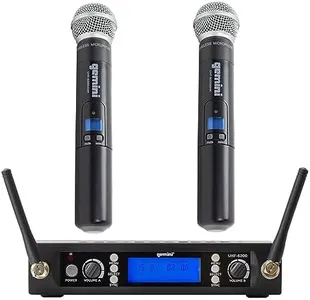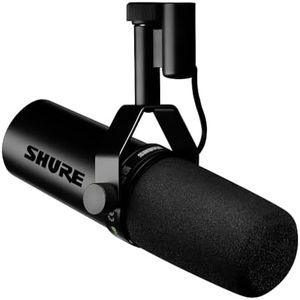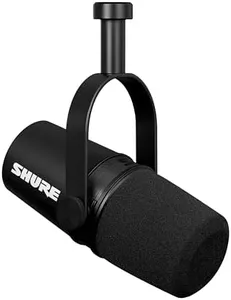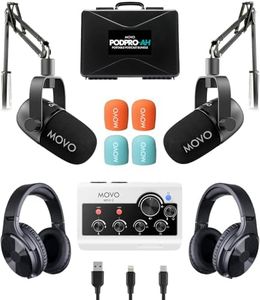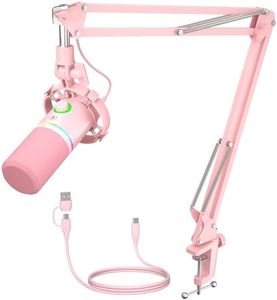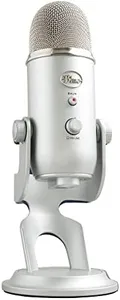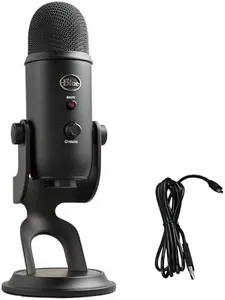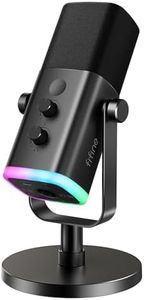Top 10 Recording Microphones Deals Right Now
Shure
9%OFF
Editor’s Choice
Shure SM7dB Dynamic Vocal Microphone with Built-in Preamp – Studio Mic for Streaming, Podcasting, and Recording – Smooth Sound, Wide Frequency Range, Rugged Build, Windscreen Included, Black
Our technology thoroughly searches through the online shopping world, reviewing hundreds of sites. We then process and analyze this information, updating in real-time to bring you the latest top-rated products. This way, you always get the best and most current options available.

Our Top Picks
Shure SM7dB Dynamic Vocal Microphone with Built-in Preamp – Studio Mic for Streaming, Podcasting, and Recording – Smooth Sound, Wide Frequency Range, Rugged Build, Windscreen Included, Black
Most important from
12415 reviews
The Shure SM7dB Dynamic Vocal Microphone is designed for streaming, podcasting, and recording. With its built-in preamp providing up to 28dB of clean gain, it ensures your voice sounds clear and natural. This microphone retains the beloved warm tone of its predecessor, the SM7B, making it ideal for broadcasters and vocalists. Its unidirectional polar pattern is excellent at rejecting background noise, which is great for recording in less-than-ideal environments.
The wide frequency response (50 to 20,000Hz) captures detailed audio across all ranges, ensuring your recordings sound professional. One standout feature is its versatile gain level setting, allowing users to choose between 18dB or 28dB boost, or bypass the preamp for the original SM7B output. This flexibility makes it suitable for various recording situations, from loud instruments to quiet vocals. The convenient bypass switch further adds to its adaptability.
However, at 2.7 pounds, it's relatively heavy and may require a sturdy mic stand. Additionally, it's powered by an XLR connector and requires 48V phantom power, which might necessitate additional equipment for some users. Despite these minor drawbacks, the Shure SM7dB is a solid choice for those looking to elevate their audio quality without the need for external preamps.
Most important from
12415 reviews
Great Choice
Shure MV7+ Podcast Dynamic Microphone – OBS Certified, Enhanced Audio, LED Panel, USB-C & XLR Outputs, Auto Level Mode, Digital Pop Filter, Reverb Effects – For Podcasting, Streaming, Recording, Black
Most important from
3678 reviews
The Shure MV7+ is designed for those involved in podcasting, streaming, or recording, providing a versatile solution with both USB-C and XLR outputs. One of its standout features is its OBS certification, ensuring that it delivers high-quality audio and integrates seamlessly with the Open Broadcaster Software, making it a solid choice for content creators. The unidirectional polar pattern focuses on sound directly in front of the microphone, reducing background noise, which is especially beneficial for recordings in less-than-ideal environments.
The microphone also boasts a multi-color LED touch panel that not only offers a stylish visual element but serves practical purposes, such as functioning as an audio level meter. It includes features like a quick mute function and a digital pop filter that minimizes unwanted plosives, enhancing sound quality. The onboard reverb options add a creative layer, allowing users to enrich their audio recordings.
There are a few considerations to keep in mind. While the MV7+ provides excellent sound isolation, some users may find it a bit bulky or heavy, especially for handheld use over extended periods. Additionally, while it offers advanced features like real-time denoising, mastering these technologies may require a learning curve for those who are not as tech-savvy. The reliance on the Motiv Mix app for optimal configuration may deter some users who prefer a more straightforward setup. The Shure MV7+ is a robust choice for podcasters and streamers seeking a high-quality microphone that combines advanced technology with user-friendly features. Its strengths lie in sound quality, versatility, and creative options, but potential users should consider their comfort with technology and the microphone's size when making a decision.
Most important from
3678 reviews
Shure SM7B Vocal Dynamic Microphone – XLR Studio Mic for Podcasting, Recording, Broadcasting, Streaming & Gaming – Smooth, Warm Sound, Rugged Build, Detachable Windscreen, Wide Frequency Range, Black
Most important from
12415 reviews
The Shure SM7B microphone is a versatile dynamic mic that excels in various recording scenarios, making it a popular choice for musicians, podcasters, and streamers alike. One of its standout features is the smooth and flat frequency response, which allows it to capture vocals and instruments with clarity and warmth. The cardioid polar pattern is beneficial for reducing background noise, ensuring that your voice is front and center without much interference from surrounding sounds. This is particularly useful in busy environments or home studios.
The microphone's rugged construction adds to its durability, making it suitable for both studio and live streaming settings. Its ability to handle close-miking applications, such as ASMR or vocal recording, further emphasizes its versatility. Additionally, the built-in air suspension shock isolation helps minimize mechanical noise, while the detachable windscreens offer flexibility during use.
There are some drawbacks to consider. The SM7B operates via an XLR connection, which means you’ll need a compatible audio interface or mixer for optimal use. Some users may find this adds complexity or extra costs if they don't already have the required equipment. Additionally, while the mic performs exceptionally well in professional settings, beginners might find it slightly overwhelming due to its broad capabilities and the need for additional gear to maximize its potential.
The Shure SM7B is ideal for serious content creators looking for high-quality audio. It's best suited for users who are willing to invest in the necessary equipment and are committed to achieving professional sound quality in their recordings. This microphone could be a fantastic addition for those ready to elevate their audio production game.
